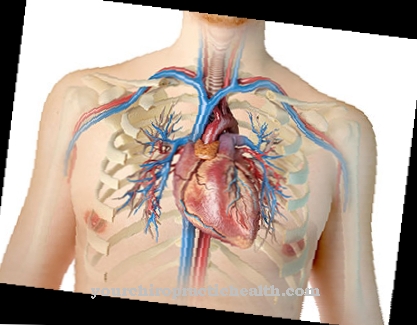The tuberous sclerosis is a hereditary disease that is associated with various malformations in the brain and with skin changes. The disease is also called after its discoverers Bourneville-Pringle Syndrome designated.
What is tuberous sclerosis?
The tuberous sclerosis is in the English-speaking area Tuberous Sclerosis Complex (TSC) called. The disease belongs to the group of phacomatoses. Phacomatoses are diseases that are characterized by malformations of the skin and the nervous system. In addition to tuberous sclerosis, neurofibromatoses and Peutz-Jeghers syndrome also belong to the phacomatoses.
One out of every 8,000 births is affected by the disease. The disease is inherited. There are malformations and tumors of the brain, developmental disorders, skin changes and organ changes. The cause of tuberous sclerosis cannot be treated. Treatment is purely symptomatic.
People with mild tuberous sclerosis usually lead normal lives. However, life expectancy is limited in the event of severe disease.
causes
Tuberous sclerosis is a hereditary disease. It is inherited as an autosomal dominant trait. In autosomal dominant inheritance, the genetic information is on one of the 22 pairs of autosomes. The disease is inherited regardless of gender. For the children of a sick person, there is a 50 percent risk that they will inherit the sick allele and thus also get sick.
If both parents suffer from tuberous sclerosis and are also heterozygous carriers, the risk of the disease rises to 75 percent. If one of the parents is homozygous, i.e. has two defective alleles, the risk of disease is 100 percent. In 30 percent of all sick people, inheritance was through father and mother. The disease occurs only sporadically in the remaining 70 percent.
Diseases caused by new mutations are possible. Even if tuberous sclerosis is only very minor in sick parents, there is a possibility that the children will later suffer from a very pronounced form of the disease.
Symptoms, ailments & signs
The tumor-like changes and the malformations in the brain are often detected very early in the sick. Cortical glioneuronal hamartomas are found in the area of the cerebral cortex. Hamartomas are tumors that arise from malformed embryonic tissue. There are bulges that result in cognitive impairments. Epilepsies can also be caused by these tubes.
So-called subependymal giant cell astrocytomas and subependymal nodules also form near the ventricular system. The impairment of the ventricular system typically results in hydrocephalus. Hydrocephalus is a pathological enlargement of the cerebral ventricles filled with liquor. Hydrocephalus is also called the head of water.
Epileptic seizures are typical of tuberous sclerosis. They often appear in the first few months of life. West syndrome can develop in infants. It is a generalized malignant epilepsy that is accompanied by lightning fits, nodding fits, and salaam fits. The more frequent the seizures, the more learning difficulties the children have.
Learning disorders are a major problem in tuberous sclerosis. Development is often impaired. Difficulties arise especially in language and movement development. Behavioral problems can also occur. Half of all patients with tuberous sclerosis, however, have a normal intelligence quotient. 30 percent of the patients have severe limitations.
Changes in the skin can occur in different forms. At first, harmless pigment disorders appear. In later childhood, reddish nodules develop in the area of the nasolabial folds. These are also known as angiofibromas. "Shagreen patches" are also typical of the disease. These are slightly raised, solidified skin lesions around the lower back. A quarter of patients develop reddish fibromatous nodules on the nail fold. These are also called Koenen tumors.
Tumors can also occur in other organ systems. The kidneys often have cysts or angiomyolipomas. Normally, however, these tumorous changes do not cause any symptoms. However, there is a risk that the tumors will become malignant. The lungs and other organs of the body can also develop tumors in the course of the disease.
Diagnosis & course of disease
The diagnosis of tuberous sclerosis is difficult, especially in younger children. The main features of the disease include angiofibromas on the face, nail fold tumors, tuberosities of the cerebral cortex and hamartomas of the retina. The minor features include confetti spots on the skin, kidney cysts or unpigmented spots on the retina.
Tuberous sclerosis is considered confirmed if there are two main features or one main feature and two secondary features. If there is a major characteristic and a minor characteristic, tuberous sclerosis is likely. If there is one main characteristic or two minor characteristics, there is at least a suspicion of tuberous sclerosis.
If the disease is suspected, various imaging methods such as ultrasound or computed tomography are used. The diagnosis can be confirmed molecular-genetically by detecting a gene mutation. However, a mutation in the TSC genes can only be detected in 85 percent of all cases of disease.
Complications
With this disease, those affected primarily suffer from various malformations that occur directly in the brain. This usually leads to cognitive and motor impairments. Furthermore, the disease can also lead to mental retardation, so that those affected are always dependent on the help of other people in their everyday lives.
The disease can also lead to epileptic seizures and, in the worst case, lead to death of the person concerned. The patients also have severe learning disabilities and therefore require intensive care. In some cases, the disease can also cause pigmentation disorders, but these do not have any further negative effects on the patient's health.
The internal organs can be infected by tumors and must therefore be examined regularly. The life expectancy of the person affected may also be significantly reduced. Since a causal treatment of this disease is usually not possible, only the individual symptoms can be restricted.
There are no further complications. The epileptic seizures can be resolved with the help of medication. However, complete healing is not achieved. In many cases, parents and relatives also need psychological treatment.
When should you go to the doctor?
Since this disease cannot heal itself, the person affected must consult a doctor. This is the only way to prevent further complications. The earlier the disease is recognized and treated, the better the further course.
A doctor should then be contacted if the person concerned has various malformations of the brain. Epilepsy can also indicate this disease and should also be examined by a doctor. In some cases, those affected also suffer from nodding fits as a result of this disease, which can lead to a significant delay in development in children. Problems with learning or speaking also strongly indicate this disease. Changes on the skin can also indicate these symptoms.
The disease itself can be diagnosed by a pediatrician or a general practitioner. In most cases, the treatment itself is carried out by a specialist and depends on the exact severity of the symptoms.
Therapy & Treatment
A causal therapy of the disease is currently not possible. Treatment is symptomatic and mostly focuses on epilepsy. Antiepileptic drugs (anticonvulsants) are used to treat epilepsy. These drugs are said to help prevent epileptic seizures.
In around 80 percent of patients, the medication can be used to achieve freedom from seizures. If it is not possible to completely prevent the seizures, at least the strength and frequency will be reduced.
prevention
Tuberous sclerosis cannot be prevented. Families in which family members already have tuberous sclerosis are advised to undergo a molecular genetic test if they wish to have children.
Aftercare
There is no causal therapy for tuberous sclerosis. The therapy is only symptomatic and mostly relates to epilepsy. Those affected are extremely limited in their life with the disease. Help from the family and relatives cannot be dispensed with. It is recommended that those affected seek advice from a psychologist.
This can help how best to deal with the disease and how to make everyday life more livable. Visiting a self-help group would only be an advantage for those affected. There you can get tips and other opinions on the way of life with tuberous sclerosis. Above all, however, those affected can talk to those who are also sick and do not feel alone.
In any case, those affected should ensure an extremely healthy lifestyle. This means that nicotine, alcohol and drugs should be avoided. A balanced diet rich in vitamins should also be ensured. Those affected have to make sure that they are not overweight. For this reason, you should do enough exercise. In any case, a healthy sleep rhythm must be observed. If those affected want to have children, it is advisable to undergo genetic counseling in advance.
You can do that yourself
Since this condition is genetic, it cannot be cured. But their symptoms can - depending on the severity - be alleviated. First and foremost, the parents of the affected children are challenged. The earlier the cognitive and motor impairments are recognized, the faster they can be treated and compensated for. Medicines can be given against the epileptic seizures. Parents should monitor their intake until the child is old enough to deal with the disease themselves.
Depending on the severity of the symptoms, tuberous sclerosis is a very stressful disease. Therefore, in many cases it is necessary for those affected and their relatives to undergo accompanying psychotherapy. They may also benefit from attending a self-help group. Corresponding addresses and information on this are available from the Tuberous Sclerosis Germany Association (www.tsdev.org). If those affected need support in coping with their everyday lives, the above-mentioned association also gives practical advice on social law assistance.
As with all chronic diseases, those affected should ensure a healthy lifestyle. This includes eating a diet rich in vitamins and nutrients, exercising, avoiding nicotine and alcohol and observing a regular sleeping / waking rhythm. Adult patients with tuberous sclerosis who wish to have children should seek genetic advice beforehand.



.jpg)
.jpg)
.jpg)



.jpg)



.jpg)



.jpg)







.jpg)


